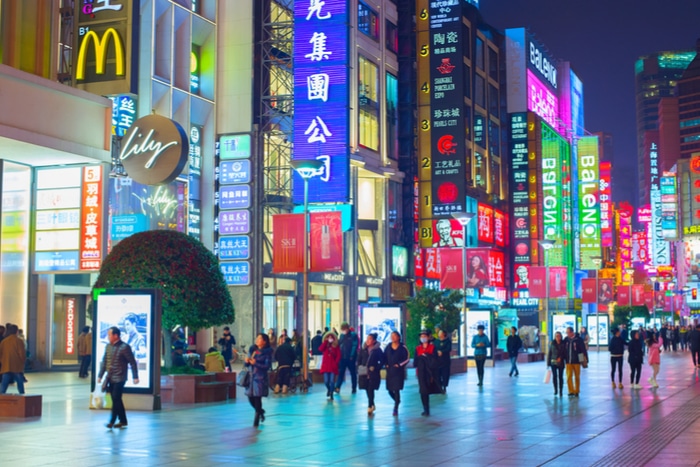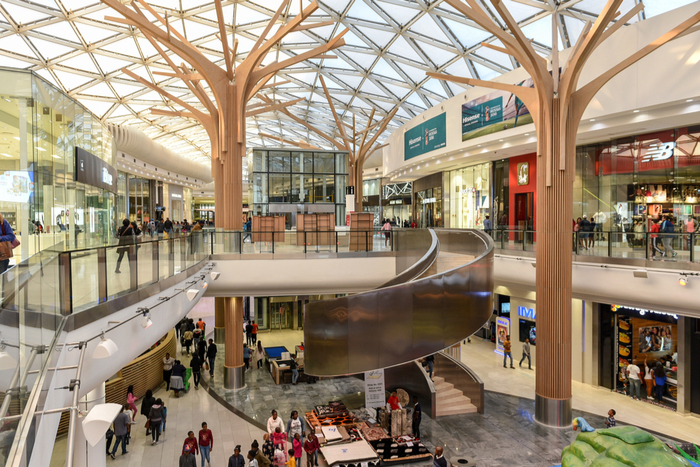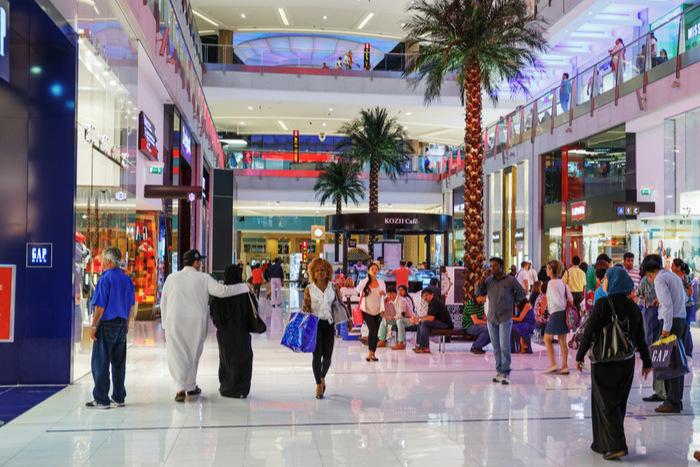It may be widely reported that China’s economy is slowing down, but this isn’t stopping the country from soon taking over the US as the world’s top retail market for the first time.
According to a report last month from research firm eMarketer, retail sales in China is slated to grow 7.5 per cent to more than $5.6 trillion (£4.2 trillion) this year, about $100 billion more than in the US. China’s growth rate is also expected to exceed that of the US right up until to 2022. And with an estimated purchasing power of 800 million consumers, China is becoming increasingly important as a market for global retailers.
“The consumer market in China represents a rich seam of opportunity for retailers, particularly if they can grasp the complexities of the region, and the preferences and behaviours of its diverse consumers,” David Lloyd, UK managing director of Chinese online retail giant Alibaba, told Retail Gazette.
Chenkai Ling, vice president of strategy and operational improvement at Alibaba rival JD.com, echoed Lloyd’s thoughts.
“Chinese consumers are increasingly quality and service conscious,” he told Retail Gazette.
“They are drawn to purchases and experiences which will improve their lifestyles or reflect their individuality.
“They are also digital natives who are used to discovering brands and placing orders via mobile.”
“Chinese consumers are increasingly quality and service conscious.”
Ling added that the ecommerce penetration rate is “very high” in China. Indeed, the rapid growth of its ecommerce sector is one of the reasons behind its retail boom. Research from eMarketer indicates that China’s ecommerce sales are predicted to grow more than 30 per cent to $1.9 trillion (£1.4 trillion) this year. Chinese online revenue also accounts for more than 35 per cent of the country’s entire retail sales, and represents the highest share globally. Compare this to the UK, where ONS data indicates that online accounts for 18 per cent of total retail sales.
Another factor driving the Chinese retail boom is the growing wealth of its consumers, which prompted a marked rise in purchasing power and average spending per person.
“A boom in the wealth of the population, combined with greater access to the global stage, has resulted in a new generation of fashion-conscious, urbane shoppers with more evolved and nuanced tastes,” Lloyd told Retail Gazette.
Alibaba remains the dominant ecommerce player in China, with its Tmall and Taobao platforms accounting for more than 53 per cent of online retail market share, according to eMarketer. This is well ahead of rival JD.com which has a market share of 16 per cent, while social commerce platform Pinduoduo is perhaps the fastest-growing thanks to triple-digit growth in the last two years.
Whereas Amazon continues to dominate the online retail sector in many other parts of the world, in China it is has long struggled to crack the dominance of Alibaba and JD.com. This is particularly manifested in the way Singles Day, Alibaba’s annual holiday event, regularly eclipses Amazon’s Black Friday in terms of revenues.
On the flip side, bricks-and-mortar retail has been in decline since the mid-2000s – although it still accounts for more than 60 per cent of entire retail sales in China. Despite this, Elena Gatti, European managing director for Azoya – a firm that helps retailers enter the Chinese market – believes the country’s physical retail sector has been “crushed” by the rise of ecommerce.
“The online market is overcrowded with domestic and overseas brands and the cost of traffic and new customer acquisition is higher than ever,” she said.
“Interestingly, the customers’ expectation and requirement on shopping experience increased as well so retailers and brands really need to be top notch in their sourcing, shipment, marketing, payment, customer service.
“Chinese consumers are probably the most spoiled in the world. They have been exposed for very convenient services in the past years and their expectations have as well.”
Gatti highlighted that retailers cannot benefit from China’s population size anymore, adding that it has become “highly competitive” and challenging to drive traffic to both physical and online stores.
“Chinese online revenue also accounts for more than 35 per cent of the country’s entire retail sales.”
“This is one of the reasons why tech companies, such as Alibaba or JD.com, must constantly develop new solutions, features, services such as ‘new retail’,” she said.
The concept of new retail implies connecting offline with online to reach the highest possible ecommerce operation efficiency through the use of data and tech in order to optimise customer experience.
Another trend that sweeping through Chinese retail is “social commerce”, which mirrors the rise of shoppable social media in much of the west. Social commerce sees retailers drive organic traffic with high return on investment and minimal marketing costs.
According to Lloyd, China was also driving the “retail as entertainment” trend more than any other country, which combines elements of new retail and social commerce so shopping became a complete social experience.
“Retailers need to adapt to these changing customer demands by using innovative technology to seamlessly merge online and offline environments, giving customers what they want, where and when they want it,” he told Retail Gazette.
“We believe physical stores still have a crucial role to play in how brands connect with their customers, as well as enhancing their marketing, inventory and supply chain.”
He added: “By combining the online and offline worlds, retailers can keep pace with these changes and continue to thrive.”
Gatti said there were some key differences between British and Chinese consumers. She said the Chinese have a penchant for convenience and bargain hunting, while also being fast adapters to new innovations and products, as seen in the rapid growth of social commerce, new retail and mobile payments.
“The more convenient the better and new features, which make life easier, are accepted quick and with a general positive attitude towards innovations,” she explained.
“When it comes to ecommerce, Chinese consumers are very demanding on shopping experience and they are used to very high service standards.
“Chinese consumers are also ‘bargain hunters’ and looking for the best price has become a kind of national sport.
“Furthermore, consumers in China love to be entertained during their online and offline shopping experience.
“In the online world it is very common that customers participate in gaming and special campaigns and retailers are very creative in offering new and exciting ways to engage customers.”
Yana Geng, who heads the UK arm of Alibaba-affiliated digital payment platform Alipay, provides further details on China’s love of mobile payment methods.
READ MORE:
“The Chinese consumer is accustomed to the ease and simplicity of alternative instant payment methods, such as mobile payments. This just isn’t as prevalent in markets such as the UK,” she told Retail Gazette.
“In China a consumer can simply scan a QR code to buy a piece of fruit, give money to a busker or complete even the most rudimentary of transactions.
“While we are seeing an increase in mobile payments in the UK, the market penetration is simply not the same as we see in China.”
Geng highlighted Alipay’s recent report on the trends of Chinese mobile payment in outbound tourism, which showed that 69 per cent of Chinese tourists used mobile payment while abroad. In addition, 94 per cent of them would be more willing to pay with their mobile phones if this method were widely adopted by retailers abroad. Simultaneously, 93 per cent would likely increase their spending if mobile payment were more widely accepted.
“This illustrates how understanding the habits and preferences of Chinese shoppers is crucial for UK merchants if they are to tap into, and embrace, this lucrative business opportunity both in China, and importantly, on home turf in the UK too,” Geng added.
Meanwhile, research from Azoya found that Chinese consumers engaged with brands a lot more than their British counterparts.
“Ninety per cent of buyers write a product review,” Gatti explained.
“Chinese customers like to share their shopping experience with their network and make product recommendations, this is quite uncommon in western countries.
“Because of some scandals with fake and dangerous products in the past, Chinese consumers need more time to trust a new brand and they first tend to trust their friends and relatives’ opinions more than a direct message from the brand.”
What about the similarities with UK retail and consumers?
“Both countries are facing massive changes and innovations,” Gatti said.
“Both are moving towards omnichannel – interestingly from two different directions. China, being a mobile-first country is connecting online with offline and in the UK the other way around.
“Plus, both countries are seeing new tools and services – mostly VR or AI – making the shopping experience more fun and exciting.”
If British retailers wanted to establish themselves in China, regulation requires them to work with a Chinese mainland partner. Gatti suggested they also have an in-depth localised strategy in China, a defined target group along with a solid strategy on which channels they will find their target group and how they can build a relationship with them. However, she warned that fake goods and fake reviews were impossible to avoid.
“China, being a mobile-first country is connecting online with offline and in the UK the other way around.”
“Regulate your sales channels and distributors and watch your product circulation closely from the very beginning. Meanwhile, put more energy in earning customers trust,” she said.
One of the most common mistakes of British retailers entering the Chinese market is their lack of merchandise localisation, a mistake that befell M&S and, more recently, New Look. Gatti said retailers needed to have stable financial support in their home country, and that they should not rely on a single touchpoint nor a single partner. She also highlighted how Chinese consumers tend to either shop for high-end or low-end brands
“Retailers in the middle level would be awkward, except H&M, Zara or Uniqlo,” Gatti explained.
“For example, New Look’s failing to position itself as high-end in China is one of the reasons why they failed there.”
Nonetheless, British brands still have a unique reputation in China – so much so, that setting up a retail presence there is becoming increasingly attractive for them.
“[Chinese] consumers increasingly want items that deliver sophistication, exclusivity and luxury,” Lloyd concluded.
“British labels have a great reputation in China, where they are considered aspirational premium products because of our reputation for creativity and quality.”
Click here to sign up to Retail Gazette‘s free daily email newsletter


















